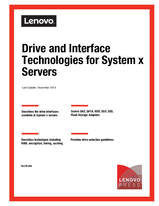Published
21 Feb 2014Form Number
REDP4791PDF size
38 pages, 409 KBAbstract
Ensuring that business-critical data is available when needed is an ever-growing need in IT. Your systems must store massive amounts of data quickly and retrieve it efficiently. At the same time, choosing the best storage technology for application data can be a complex task, because you must ensure that business requirements are met, yet contain costs under tight budget limits. Storage performance capabilities need to match the processing capabilities of the server to ensure the most efficient use of system resources. There is no “one size fits all” approach possible because different applications have different storage data access patterns.
The choice of drives for server internal storage is broad. Therefore, this requires you to consider several factors, including connectivity interfaces, such as Serial Advanced Technology Attachment (SATA) or serial-attached SCSI (SAS); the speed of these interfaces; types of drives: hard disks, solid-state storage, or hybrid drives; rotational speeds; choice of desktop versus nearline versus enterprise drives for hard disk drives (HDDs); enterprise versus enterprise value for solid-state drives (SSDs); form-factors; and so on. So how do you choose the most appropriate drive type?
This paper describes currently available internal and external direct-attach storage (DAS) interfaces and drive types that are available for System x servers and provides suggestions on how to choose the best options for business needs and application requirements.
Table of Contents
Introduction
Serial Advanced Technology Attachment (SATA)
Serial-attached SCSI (SAS)
Hard disk drives
Flash internal storage
Self-encrypting drives
Storage tiering
SSD caching
Storage performance considerations
Redundant Array of Independent Disks (RAID)
Drive selection guidelines
Configure and Buy
Full Change History
Course Detail
Employees Only Content
The content in this document with a is only visible to employees who are logged in. Logon using your Lenovo ITcode and password via Lenovo single-signon (SSO).
The author of the document has determined that this content is classified as Lenovo Internal and should not be normally be made available to people who are not employees or contractors. This includes partners, customers, and competitors. The reasons may vary and you should reach out to the authors of the document for clarification, if needed. Be cautious about sharing this content with others as it may contain sensitive information.
Any visitor to the Lenovo Press web site who is not logged on will not be able to see this employee-only content. This content is excluded from search engine indexes and will not appear in any search results.
For all users, including logged-in employees, this employee-only content does not appear in the PDF version of this document.
This functionality is cookie based. The web site will normally remember your login state between browser sessions, however, if you clear cookies at the end of a session or work in an Incognito/Private browser window, then you will need to log in each time.
If you have any questions about this feature of the Lenovo Press web, please email David Watts at dwatts@lenovo.com.

